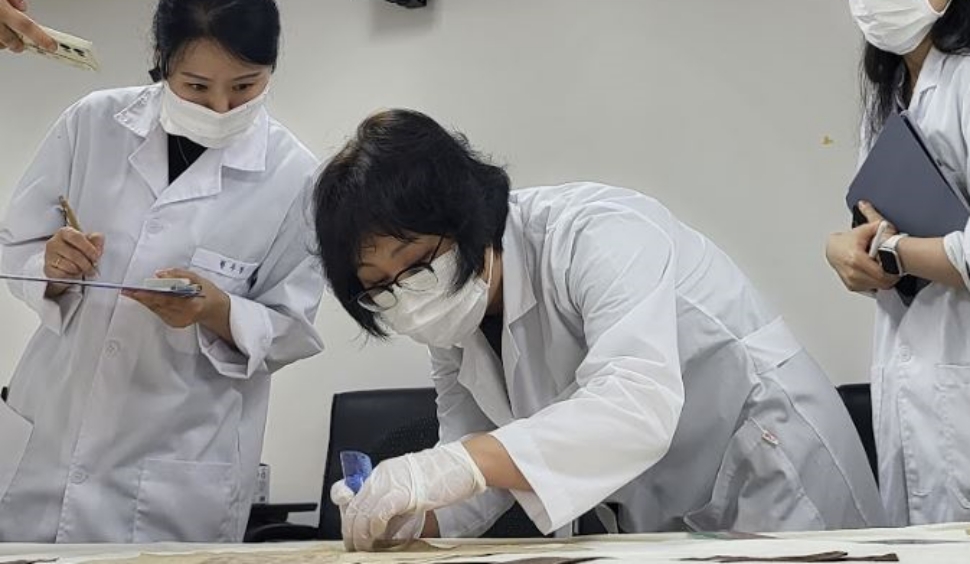[Nov] Korea's hanbok finds new life on global fashion’s digital stage
Date Nov 24, 2023
 Students wear replicas of hanbok worn by Lady Yun (1660-1701) of the Haepyeong Yun clan during an exhibition at Seokjuseon Memorial Museum of Dankook University (Photo by department of Korean and Asian Traditional Dress at Dankook University)
Students wear replicas of hanbok worn by Lady Yun (1660-1701) of the Haepyeong Yun clan during an exhibition at Seokjuseon Memorial Museum of Dankook University (Photo by department of Korean and Asian Traditional Dress at Dankook University)
Hanbok lies in the heart of Korea’s cultural identity. The traditional attire is much more than clothing – it is a canvas of history, art and the nation’s ethos. With its graceful lines and vibrant colors, hanbok embodies the spirit and aesthetic of a nation that values refinement and simplicity.
Choi Yeon-woo, a professor in the Department of Korean and Asian Traditional Dress at Dankook University, has been at the forefront of the study and preservation of hanbok. This year, she and her students have meticulously recreated the Jeongjae Yeoryeong costumes, once a vibrant part of royal festivities, thus reinvigorating hanbok's historical resonance.
The Musin Jinchan is a royal feast celebrated in 1848 during the reign of King Heonjong of Joseon, as the king wished longevity for his grandmother and mother. Central to this event was the Jeongjae dance, performed by dancers called Jeongjae Yeoryeong.
The dancers donned attire that is particularly noteworthy, encapsulating the essence of court culture. Through the five elemental colors of blue, red, yellow, white and black, these garments portrayed a philosophy of symbiosis, weaving the idea of balance and harmony into their very fabric.
"These costumes utilize light, airy fabric such as sa [rough silk], gapsa [fine silk] and cho [raw silk], as they have to complement dancers' movements," Choi said.
 Professor Choi Yeon-woo of the Department of Korean and Asian Traditional Dress at Dankook University, center, and her students examine the clothes of Lady Yun (1660-1701) of the Haepyeong Yun clan for a restoration project (Photo by department of Korean and Asian Traditional Dress at Dankook University)
Professor Choi Yeon-woo of the Department of Korean and Asian Traditional Dress at Dankook University, center, and her students examine the clothes of Lady Yun (1660-1701) of the Haepyeong Yun clan for a restoration project (Photo by department of Korean and Asian Traditional Dress at Dankook University)
Professor Choi defines the aesthetic of hanbok as “refined beauty,” where decoration is balanced and not overwhelming, and the Jeongjae Yeoryeong costumes are an example of this principle.
The task of reviving these garments to their historic authenticity requires a comprehensive analysis of written texts, physical artifacts and paintings. The challenge lies in authentically reproducing the apparel as it was worn historically, maintaining the integrity of shapes, colors and patterns. The restoration relied on illustrations in the “Painting of the Royal Banquet in Musin Year,” the “Musin Jinchan Uigwe” (Royal Protocol at the Musin Year Feast) and other documents.
This year marked a technological breakthrough as Choi’s team introduced a new technology to take the hanbok experience to another level. CLO, 3D fashion design software, allows designers and novices to alter hanbok patterns to fit specific measurements and create virtual clothing instantly. The new medium lets people explore and interact with hanbok, potentially paving the way for greater globalization.
The sweeping wave of Korean culture, characterized by the worldwide appeal of K-pop, -dramas and -beauty, has brought hanbok into the limelight as well.
Park Sun-hee, another instructor at Dankook University, emphasized that hanbok serves as a bridge to Korea's rich history and traditions now and that education plays a crucial role in this cultural dissemination.
"By introducing hanbok culture through both theoretical and experiential classes worldwide, Korea is nurturing an international appreciation for hanbok," Park said.
Integrating hanbok into school curriculum can familiarize children with its significance from a young age, making it a living culture rather than a relic of the past. Park’s dedication to nurturing hanbok cultural educators underscores the importance of passing on this heritage, and she adopted the Korean Culture and Information Service’s book “K-Culture” as a resource for her classes to recognize the importance of cultural promotion.
As Korean culture permeates the global stage, hanbok too has evolved. Today's hanbok seamlessly blends traditional elements with contemporary designs, resonating with modern fashion while respecting its roots.
The rise of everyday clothes that incorporate hanbok features speaks to its growing appeal and adaptability. Professor Choi believes that respecting the heritage while adopting modern design innovations is crucial for preserving the distinctive cultural identity of hanbok.

The Ministry of Culture, Sports and Tourism's "Korea Here & Now" work can be used under the condition of "Public Nuri Type 1 (Source Indication)."




